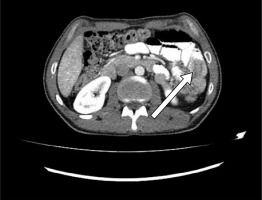Intussusception is a process in which a segment of intestine invaginates into the adjoining intestinal lumen, causing bowel obstruction. It is a common paediatric surgery emergency, and it requires early diagnosis and treatment. Intussusception typically presents at between 6 and 36 months of age, and the male-to-female ratio is approximately 3 : 1. It is usually ileocolic, although other forms such as Ileo-ileal, jejuno-jejunal, jejuno-ileal, or colo-colic have also been described [1]. However, in adults the overall incidence of intussusception is around 2–3 cases per 1,000,000 of the general population annually, and it is usually secondary to an existing pathology [2, 3]. According to the literature, 30% of small bowel intussusceptions are caused by tumours, while 10% are idiopathic [4–6]. We herein report a case of a 30-year-old male with idiopathic transient small bowel intussusceptions.
A 30-year-old male with free medical history and no surgical intervention presented to our Emergency Department complaining of epigastric pain for 7 days. The pain was moderate in severity and associated with nausea and vomiting. There was no history of haematemesis or melena. On examination, moderate tenderness was revealed in the region of the upper abdomen with no rebound tenderness. Bowel sounds were audible, and rectal examination was normal. His vital signs were unremarkable. His routine blood tests including haemogram, C-reactive protein level, liver and renal function test, serum amylase, and lipase were normal. Chest and abdominal radiography showed no abnormalities. A further computed tomography (CT) scan of the abdomen revealed a short segment of small bowel intussusception at the left upper quadrant with a doughnut sign (or target sign) appearance (Figure 1). No signs of obstruction or ischaemia were recognized. The patient was hospitalized for 5 days in the surgical clinic and underwent exploratory laparotomy the 5th day of his hospitalization because symptoms of pain and vomiting were persistent. In the operating room, following general anaesthesia, a midline incision was performed. The small bowel was inspected from the ligament of Trietz till the ileo-caecal valve. During the running of the small bowel no visible masses or other pathologies were recognized. The patient did not have any postoperative complications, and he was mobilized 12 h postoperatively. He was started on an oral diet on postoperative day 2 and was discharged on postoperative day 4. He had a small bowel follow-through study 1 month post-surgery, which was normal.
Figure 1
A computed tomography scan of the abdomen (transverse section) showing small bowel loops invaginated into a proximal bowel loop, indicating small bowel intussusceptions and a doughnut sign (target sign) appearance at the left side of the abdomen. There were no signs of bowel ischaemia or obstruction

Intussusception is prescribed as the invagination of a proximal segment of the gastrointestinal tract into the lumen of the contiguous distal segment [7]. The mechanism behind intussusception could be explained by the presence of a bowel lesion that alters the normal peristaltic movements and serves as a lead point for intussusceptions [8]. This pathogenesis can occur at any age, but it is most common in children. Adult intussusception is usually caused by a pathologic lead point within the bowel, and over half of the cases are caused by malignancy [8, 9]. The transient intermittent small bowel intussusception is a rare condition with only a few similar cases reported in the literature [3]. Abdominal pain is considered to be the most common symptom in adults with intussusceptions; however, sometimes the patient is asymptomatic [10]. Computed tomography (CT) of the abdomen and pelvis is the most useful diagnostic tool for the diagnosis of intussusceptions as well as for identifying the lead point in intussusceptions [3].
There are no data in the literature from which to draw any standard therapy of bowel intussusception. Surgery is an option in adults with pathological intussusceptions, while the transient type can be managed conservatively in the absence of any abdominal symptoms or complications [3].










